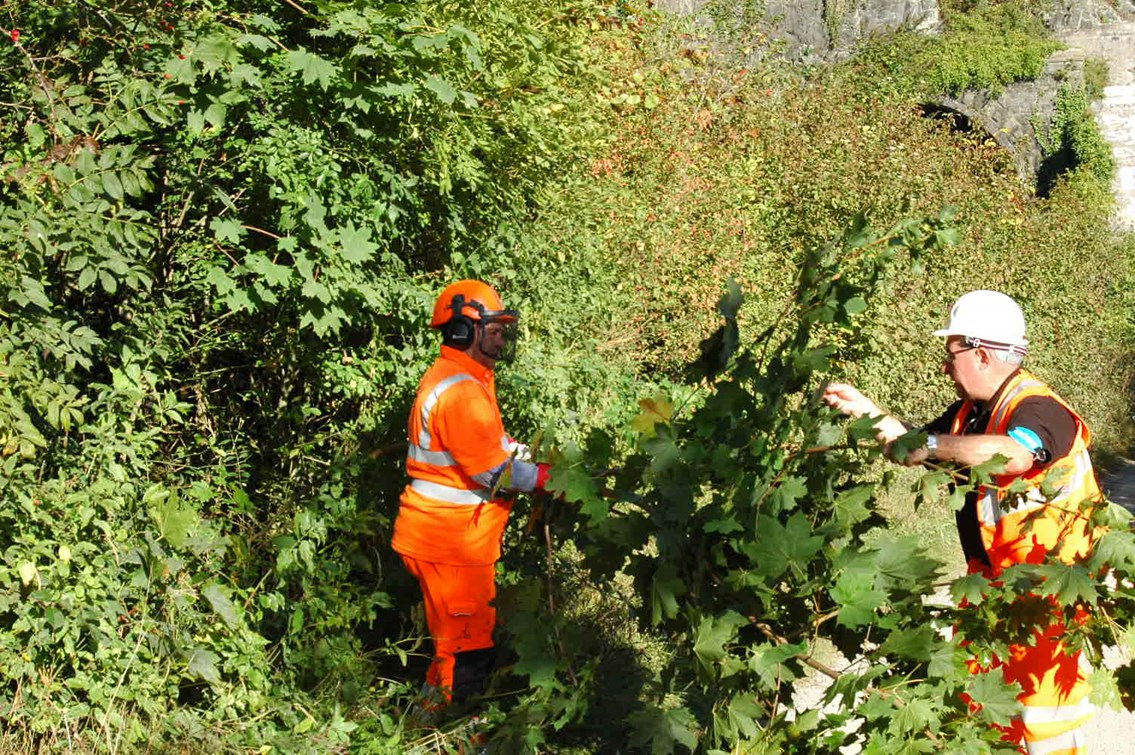Monday 26 Sep 2016
Wirral residents invited to drop-in event to learn more about vegetation work taking between Hooton and Bromborough.
- Region & Route:
- | North West & Central
Network Rail is holding an information drop-in event to explain upcoming vegetation work on the Wirral.
2.5 miles of vegetation management work will take place over four weeks starting on Monday 17 October between Hooton and Bromborough. The work is essential to keep passengers and workers safe.
Last year across Britain around 1,000 trains collided with fallen trees or large branches – a number Network Rail is keen to reduce. Each year there are increased instances of trees and branches blocking or closing lines, disrupting passengers’ journeys.
Cutting trees and vegetation back to a safe distance from the tracks allows train drivers to clearly see signals – the traffic lights of the railway – and to spot potential hazards as soon as possible.
At the event, which takes place on Wednesday 28 September between 4pm and 6.30pm at Delamere (community) Centre, Delamere Ave, Wirral, CH62 9ED , Network Rail staff will be on hand to explain why this work is so important for railway safety and how they will tackle the challenge in this area.
Wayne Evans, project manager for Network Rail said: “Vegetation management is an essential part of railway maintenance and is crucial to keeping both trains and passengers safe on the network.
“We encourage our lineside neighbours to come along to understand the work we are doing and how it may affect them. Our project team will be on hand to answer any questions and address any concerns they may have.
For further information contact Network Rail’s national helpline on 03457 114 141.
ENDS
Notes to editors:
Vegetation removal – the facts
In 2013 incidents caused by vegetation cost the railway industry £100m. Storm, rain and wind events resulted in approximately 1,500 incidents in 2013-14 where trees caused disruption to the network.
With 20,000 miles of track and an estimated 2.5 million trees growing on the lineside, managing vegetation on the railway is not just a full-time job but one of our most important safety issues. Our climate, variety of trees and train frequency mean that the railway in Great Britain faces more serious challenges than most other countries.
Lineside vegetation can obscure signals, get blown onto the tracks, or grow to an extent where our staff do not have a safe place to wait whilst trains pass.
We will be removing lineside trees and plants which pose a significant safety or performance risk. Vegetation management also helps to prevent leaves falling on the track which can hamper train acceleration and braking.
Areas are assessed on a case-by-case basis, however all sites will see a clear six-metre wide corridor created (where available) on either side of the track, along with the removal of leaf fall species (for example ash and sycamore) and any trees tall enough to fall into the path of a train or onto other parts of the railway infrastructure.
Before works start Network Rail or our representatives carry out an ecological survey. Any protected species or nesting birds are identified and appropriate methods of working are put into place. Although the works do not require the submission of a planning application, where appropriate we will notify your local authority and any relevant statutory bodies.
To undertake these works, we will use a variety of equipment that can include chainsaws, flail machines, chipping machines or handsaws. Where suitable, logs and branches will either be left to create a safe habitat for wildlife; chipped and spread evenly; or will be completely removed from site.
Works will often be required to take place when trains are not running, but every effort is made to keep controllable noise to a minimum and our staff are briefed on working responsibly in the local community.
Network Rail is very aware of the impact removing trees and vegetation can have on local communities. We particularly know that this can come as a something of a shock for people who have become accustomed to lines of trees or hedges near their homes or workplaces. However, for the safety of our passengers and employees we have no option but to take action to reduce the risk posed in order to operate a safe and reliable railway.
Contact information
Passengers / community members
Network Rail national helpline
03457 11 41 41
Latest travel advice
Please visit National Rail Enquiries
Journalists
Network Rail press office - North West & Central Region
07740 782954
NWCmediarelations@networkrail.co.uk
About Network Rail
We own, operate and develop Britain's railway infrastructure; that's 20,000 miles of track, 30,000 bridges, tunnels and viaducts and the thousands of signals, level crossings and stations. We run 20 of the UK's largest stations while all the others, over 2,500, are run by the country's train operating companies.
Usually, there are almost five million journeys made in the UK and over 600 freight trains run on the network. People depend on Britain's railway for their daily commute, to visit friends and loved ones and to get them home safe every day. Our role is to deliver a safe and reliable railway, so we carefully manage and deliver thousands of projects every year that form part of the multi-billion pound Railway Upgrade Plan, to grow and expand the nation's railway network to respond to the tremendous growth and demand the railway has experienced - a doubling of passenger journeys over the past 20 years.
Follow us on Twitter: @networkrail
Visit our online newsroom: www.networkrailmediacentre.co.uk

